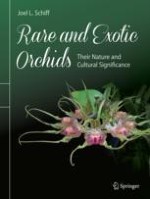2018 | OriginalPaper | Buchkapitel
2. What Are Orchids?
verfasst von : Joel L. Schiff
Erschienen in: Rare and Exotic Orchids
Aktivieren Sie unsere intelligente Suche, um passende Fachinhalte oder Patente zu finden.
Wählen Sie Textabschnitte aus um mit Künstlicher Intelligenz passenden Patente zu finden. powered by
Markieren Sie Textabschnitte, um KI-gestützt weitere passende Inhalte zu finden. powered by
